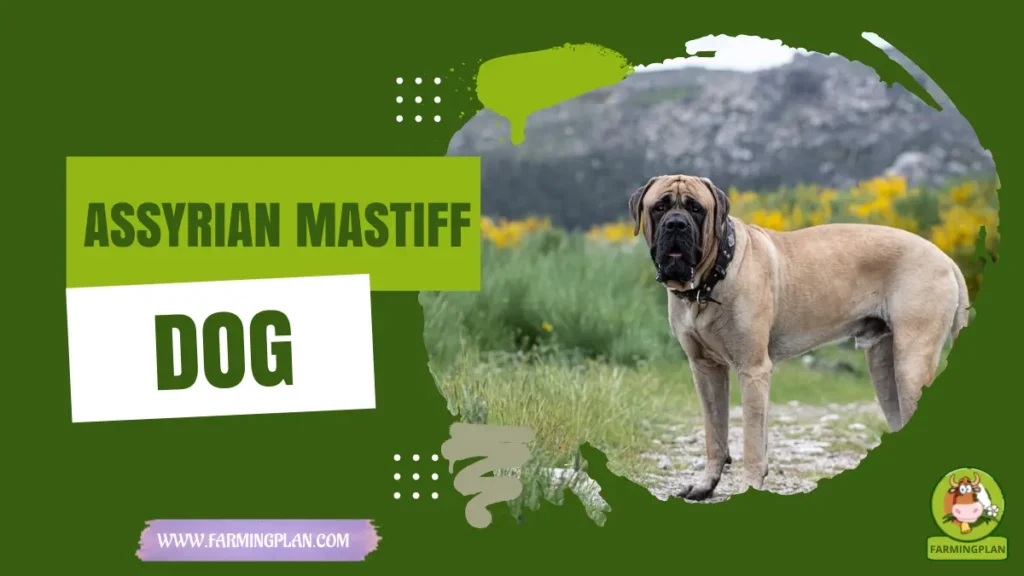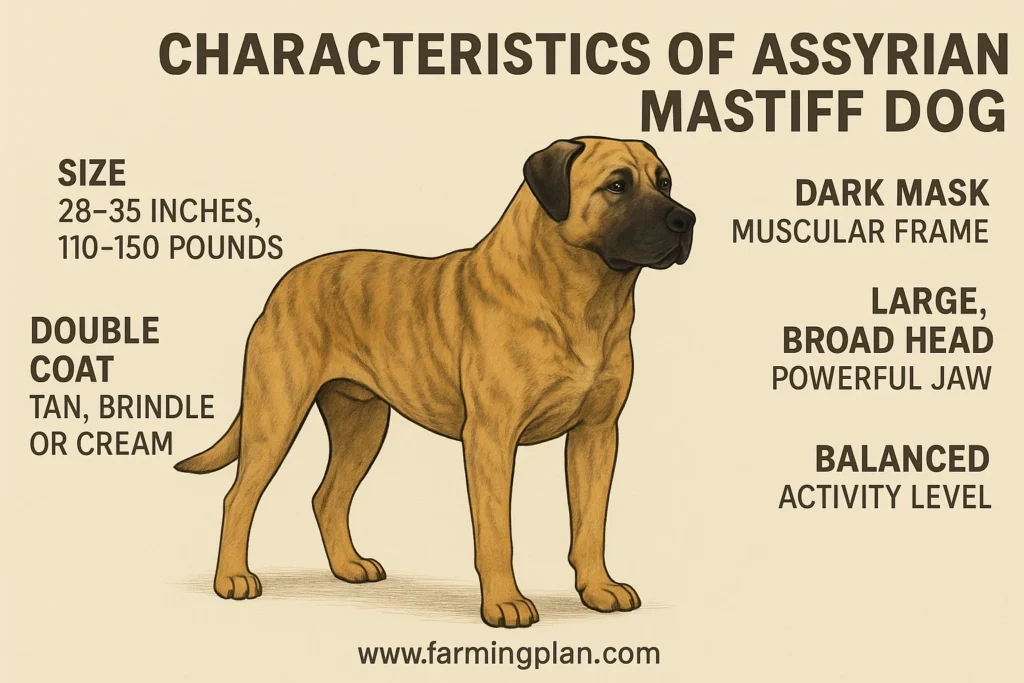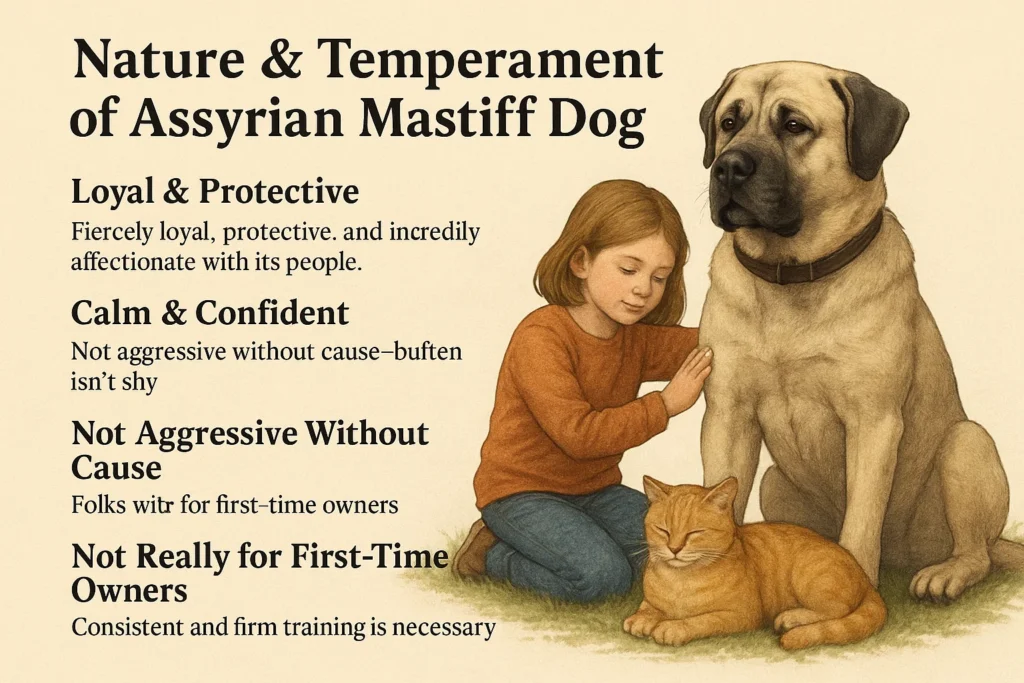If you’ve ever dreamed of owning a dog that looks like a lion and guards like a soldier, meet the Assyrian Mastiff Dog. This ancient, powerful breed is known for its loyalty, protective nature, and deep bond with its family. With roots tracing back to Mesopotamia, it’s more than just a striking dog—it’s a dependable working companion. Whether you’re a farmer, breeder, or simply looking for a strong, devoted guardian, this breed delivers. Curious how it compares to other mastiffs like the Tibetan or Neapolitan Mastiff? This guide covers it all—from history and traits to feeding, training, and health care—everything you need to know about raising an Assyrian Mastiff Dog.

History & Origin of Assyrian Mastiff Dog
The Assyrian Mastiff Dog has a rich history that dates back to Mesopotamia and the mighty Assyrian Empire. These dogs were originally bred to guard livestock and protect people in harsh terrains. Their likeness can even be found carved into ancient stone walls, standing tall beside warriors and kings. This historical significance adds a unique depth to the breed, making it more than just a pet-it’s a living link to a powerful past.

This breed wasn’t just a household pet—it was a status symbol and a working partner. They were raised to be fearless, fighting off wild animals and guarding herds across what is now Iraq, Syria, and Turkey. You can spot their resemblance to other powerful breeds like the Abruzzese Mastiff or Tibetan Mastiff, but the Assyrian version kept its raw, functional traits. They survived through centuries because of their sheer usefulness and loyalty. The modern Assyrian Mastiff dog still carries that same instinctual drive and ancient presence. Trust me, when you look into their eyes, you feel the weight of history behind them.
Read More: Zerdava Dog: The Loyal Hunter You’ll Love at Home
Characteristics of Assyrian Mastiff Dog
These dogs are anything but subtle. The Assyrian Mastiff Dog stands out for its impressive size, typically ranging between 28 to 35 inches tall and weighing anywhere from 110 to 150 pounds. Despite that, they move with surprising grace and purpose.

Their muscular frame is wrapped in a thick double coat, usually tan, brindle, or cream. Some even have a dark mask, which makes them look even more intimidating to strangers—but don’t worry, they’re all heart when it comes to their family. Their large, broad head and powerful jaw give them the mastiff’s signature “don’t mess with me” look. Compared to other mastiff breeds, they’re right in the middle when it comes to activity. Not hyper, not lazy—just balanced. And believe it or not, they’re medium-size when you compare them to extreme giants like the English or Tibetan Mastiff. But don’t tell them that—they walk like kings.
Read More: Armant Dogs: Loyal, Intelligent, and Family Friendly
Nature & Temperament of Assyrian Mastiff Dog
Here’s where this breed really shines. The Assyrian Mastiff Dog is fiercely loyal, protective, and incredibly affectionate with its people. They have a calm and confident temperament, which can be seen in their interactions with children and other pets. I’ve seen these dogs go from napping beside kids to launching into full guardian mode the second they sense a threat. They’re not aggressive without cause—but they’re not shy either. You’ve got to understand, this breed was born to protect. That makes them perfect for farms, ranches, and large properties where they can roam and stand guard.

With proper training and early socialization, they can be calm and confident companions. They’re not really lap dogs (unless your lap is a picnic bench), but they’ll be by your side through thick and thin. For first-time owners, they might be a bit much—this breed is best suited for folks with experience handling big, strong-willed dogs. Consistent and firm training is key to managing their protective instincts and ensuring they are well-behaved members of the family.
Read More: Basque Shepherd Dog: Start A Successful Farm
Food & Diet
A big dog like this needs big-time nutrition. I feed my Assyrian Mastiff Dog a balanced diet full of high-quality protein and healthy fats. Puppies need about 3 to 4 meals a day, while adults do just fine with two solid meals.
Stick to real meat-based kibble or a raw food diet if you’re into that—just make sure you’re avoiding fillers like corn or soy. Joint supplements like glucosamine are great, especially since these dogs carry a lot of weight on their frames. Here’s my tip: avoid overfeeding. These dogs may beg like pros, but too much food leads to weight gain, which stresses their joints. Clean, fresh water is a must, especially during summer months or heavy workdays on the farm.
Usage & Purpose
The Assyrian Mastiff Dog isn’t just sitting around looking pretty. This breed has always been used for working, especially as a livestock guardian dog. Whether it’s sheep, goats, or even chickens, these dogs take protection seriously.
On my own farm, they patrol the perimeter and alert me if anything seems off. They’re also great deterrents for trespassers—just the sight of them will make most folks think twice. Beyond farm life, some owners use them for property protection, security roles, or simply as loyal companions. They’re not show dogs like the Neapolitan Mastiff, but they do turn heads wherever they go. This is a purpose-driven dog, happiest when it has a job to do.
Special Features
One of the Assyrian Mastiff Dog’s standout traits is its mix of power, stamina, and intelligence. They’re one of the few mastiff breeds that strike a great balance between size and mobility. Unlike the clumsier giant breeds, these dogs stay agile and alert.
Their thick coat helps them adapt to hot or cold climates, and their independent nature means they can make decisions in the field without constant guidance. They’re naturally nocturnal protectors, often taking on night patrols around the property. Another fun fact? These dogs bond deeply with one or two people. Once they decide you’re theirs, you’ve got a friend and protector for life.
Big Dogs Need Big Love—And The Assyrian Mastiff Returns It Tenfold With Loyalty, Power, And Heart.
Health Issues & Prevention
Like most large breeds, the Assyrian Mastiff Dog is prone to a few health concerns—mainly hip dysplasia, bloat, and joint issues. Regular vet checkups and keeping their weight in check goes a long way.
I recommend joint supplements and a moderate exercise routine. Letting them run on soft ground like grass is better than hard pavement. For puppies, don’t over-exercise—let those joints develop properly. Make sure you’re deworming regularly and vaccinating according to schedule. Clean ears, trim nails, and always check their eyes and skin for irritation. A healthy Assyrian Mastiff can live around 10 to 12 years, sometimes more with good care.
Step-by-Step Pet Owner Care Guide
Step 1: Prepare Your Home & Yard
Before you bring your pup home, make sure your yard is fenced and secure. These dogs are territorial and need space to roam. Provide a shaded area, fresh water source, and a comfy kennel or dog house. Inside the house, keep sharp objects and fragile things out of reach. Puppies especially are curious and can knock things over just by wagging their tails.
Step 2: Choose A Responsible Breeder
If you’re buying an Assyrian Mastiff dog for sale, only go through a trusted breeder. Ask for health clearances, parent info, and photos of the litter. A good breeder will answer your questions and offer support even after you bring the pup home. Watch out for shady listings with no background info or poor living conditions. A healthy puppy starts with a healthy home.
Step 3: Socialization & Training
Start socializing early. Introduce your pup to new people, dogs, sounds, and situations. Positive reinforcement works best—these dogs respond well to praise and treats, not punishment. Basic commands like sit, stay, and heel are essential. Consider working with a trainer experienced in large breeds if you’re new to training.
Step 4: Daily Care & Exercise
Give them at least 45–60 minutes of exercise daily. A mix of leash walks, yard time, and light training games works well. Avoid rough play with small children—it’s not that they mean harm, but they don’t always know their strength. Brush weekly to keep their coat healthy. Bathing once every couple of months is enough unless they roll in something nasty (which they sometimes do).
Step 5: Routine Health Checkups
Take your dog for regular vet visits—at least twice a year. Get a full physical, check hips and joints, and stay up to date on all shots. If you notice limping, bloating, or unusual behavior, call your vet immediately. Don’t skip dental care either. Dental chews or brushing a couple times a week helps prevent gum issues down the road.
Expert Tips & Best Practices
- Start early with obedience training. Big dogs grow fast, and bad habits can become big problems.
- Feed a breed-specific diet. Avoid fillers and stick to meat-first formulas.
- Secure your fence. These dogs patrol and protect—you don’t want them chasing coyotes off your land.
- Use a slow-feed bowl. It helps prevent bloat, a serious issue in large breeds.
- Give them a job. Whether it’s guarding, herding, or just walking the perimeter, they need purpose.
FAQ
What is the Assyrian Mastiff Dog used for?
They are mainly used as livestock guardians and protectors. Their loyalty and size make them excellent watchdogs too.
How big does an Assyrian Mastiff get?
They can grow up to 35 inches tall and weigh around 150 pounds, depending on gender and diet.
Are Assyrian Mastiffs aggressive?
They’re protective but not naturally aggressive. Proper training and early socialization make them calm and confident.
What’s the difference between an Assyrian Mastiff and other mastiff breeds?
They’re more agile and work-focused compared to showier mastiffs like the Neapolitan. They also have deep historical roots in Mesopotamia.
How much does an Assyrian Mastiff cost?
Prices vary, but you can expect anywhere from $1,500 to $3,000 from a reputable breeder.
Conclusion
The Assyrian Mastiff Dog is a bold, beautiful, and loyal companion that’s built for purpose. Whether you’re guarding livestock or looking for a loyal friend, this impressive mastiff breed offers intelligence, strength, and a whole lot of heart. With the right care, space, and training, they’ll become a vital part of your life and family. Thinking about getting one? Start with a plan, commit to the journey, and you’ll earn a dog that’s fiercely devoted and deeply rewarding.
